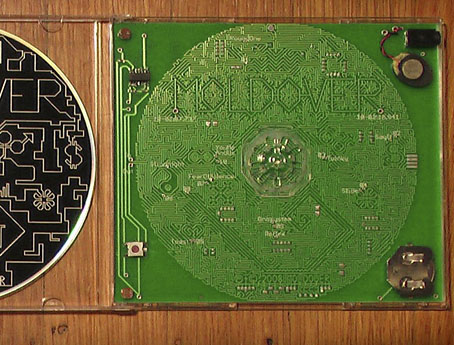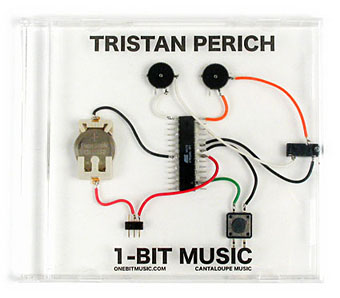Moldover’s CD case: a working theremin.
In May this year, Brian Eno was writing in Prospect magazine about the current state of the music business as it continues to be assailed by digital technology. Among the things Eno discussed was the packaging of music:
The duplicability of recordings has had another unexpected effect. The pressure is on to develop content that isn’t easily copyable—so now everything other than the recorded music is becoming the valuable part of what artists sell. … That suggests to me the possibility of a refreshingly democratic art market: a new way for visual artists, designers, animators and film-makers to make a living. So, as one business folds, several others open up. (More.)
Having started out as an album cover artist (I wasn’t a designer back then), and working still as a CD designer, this is naturally an attractive thesis. Earlier this week John Walsh in The Independent wrote a potted history of the album cover and noted that the big record companies are also realising again that contemporary music as an artform is more than merely a collection of audio tracks:
Apple, creator of the iPod and the iTunes store—the sworn enemies of commercially-packaged music—is getting into bed with the four largest record labels, to help them stimulate album sales. They’re working with EMI, Sony Music, Warner Music and Universal Music Group on something called “Project Cocktail” that will produce all manner of extras to go with albums: interactive booklets, sleeve notes, photographs, lyric sheets, even video clips. Buyers will be able to call up album tracks through the interactive booklet, while leafing through pictures of the band and trying to make sense of the lyrics.
This, however, seems to be missing the point. Absolutely anything digital can be copied and passed on, and that applies equally to album extras as to the tracks themselves. What can’t be copied, of course, is a desirable object which contains the music. The lavish album sleeves of the 1970s were very much desirable objects which contained music, and no end of facsimile CDs of Physical Graffiti will match the impact of Peter Corriston and Mike Doud’s design for the vinyl release.
Which brings us to Moldover‘s extraordinary light-operated theremin-in-a-CD-case, a beautiful design and a really clever use of the wretched jewel case box. The music on Moldover’s accompanying CD may be swapped around illicitly but no one is going to copy the hardware. The “Awesome Edition” of this work costs $50 and can be ordered here.
Moldover’s theremin is only an adjunct to his music, albeit a delightful one. Tristan Perich, on the other hand, like Fm3’s Buddha Machine, makes the case and the instrument one, and in Perich’s case (so to speak) possibly takes the 8-bit/chiptune thing to a definitive extreme. This is the kind of invention we could use more of, not some lazy Flash applications appended to a pop release then dumped onto the iTunes Store as an “exclusive”. It’s notable that the one thing all these works have in common is that they’re the inventions of no-budget independent artists, not big record labels.
While we’re on the subject of the Buddha Machine, the guys at Mountain*7 noted this YouTube loop work which extends the drone-loop idea into the audio/visual realm.
Elsewhere on { feuilleton }
• The album covers archive
Previously on { feuilleton }
• Buddha Machine Wall
• God in the machines
• Layering Buddha by Robert Henke
• Generative culture



For what it’s worth, I think the intention of Cocktail and equivalents is more about encouraging people to purchase an album’s worth of tracks, rather than individual songs, rather than an attempt to create ‘uncopyable work’.
Personally – despite the fact that I still buy vinyl and CDs – I think the whole thing of ‘let’s subsidise recorded music for 95% of people by charging 5% of people large amounts for art editions’ doesn’t strike me as a viable way forward. Ditto with books. You can’t be a digital revolutionary on the one hand, while suggesting your digital revolution should be funded by the old guard.
That strikes me as a bit like, if at the early C20th, someone suggesting that roads for cars could be funded by steadily increasing taxes on the declining number of horse users.
(And I’m already balking at some of the prices I’m being asked to pay).
Nice! I really like the discussion about the artifact of music. I try to preserve them by highlighting their creativity, the magic of vinyl, the amazing photographers and musicians that added to our culture. Hopefully someday someone will commission me to do a series of portraits framed next to the amazing album covers. Can’t afford the frames yet…
Peace.
Hi Jules. I see music evolving along similar lines to the book world actually, which for years has given readers choices of different editions of the same work, from expensive signed and illustrated volumes, down to cheap paperbacks. Over the past couple of decades the tendency has been to weight production towards the cheaper end of the scale, whether for books or music. I think now we may start to see the centre of gravity shifting with a range of formats available. There’s still a demand for vinyl, after all, despite being told for years it was finished. Many of the dubstep releases I’ve been designing recently have been produced in CD and vinyl versions. At Savoy Books we showed you could sell out a new edition of a work such as David Lindsay’s A Voyage to Arcturus, despite the text being freely available, by producing the best edition anyone has done of it to date. I’m still sceptical as to what big record companies are going to come up with but that’s my bias showing.
Hi Daniel. A few of my early (and rather poor) works for Hawkwind were produced on picture discs which were a gimmicky trend the record companies were trying for a while. Most of those releases I’ve never seen copies of, I didn’t always get sent the finished works.
From what I can tell on Chris Carter’s site there’s some kind of Throbbing Gristle BM-style device in the works, which should be all kinds of wonderful. I’m also reminded of the recent Warp Records box set, which came with a locked-groove vinyl disc – an interesting one, I think, as it’s obviously very easy to recreate a locked groove digitally (and from any source you can think of), yet there’s something… different about the process being achieved physically on wax…
Lovely, a real masterpiece CD )
3lbFlax: I always liked locked grooves, in fact I wonder who made the first one. Hawkwind had one on their second album, In Search of Space, and The Beatles famously had one at the end of Sgt Pepper. Needless to say, these are never the same on CD, they just play for a while then fade out.
23 Skidoo liked them a lot; the last track on side one of Seven Songs is called ‘Lock Groove’. On the album they made after that, The Culling is Coming, the live side played up to half-way through then stuck in a locked groove which looped for as long as you wanted. You could then move the stylus to the second part of the performance or you could play a self-contained locked groove in the centre of the record which featured a voice saying “The culling is coming” over and over. That voice provides the album’s title but is completely absent from CD reissues.
I have a kind-of-techno EP by Legion of Green Men made of nothing but tracks that end in locked grooves, which I didn’t realise when I first played it, and it took me a while to realise. And of course I have countless unintentional locked grooves… But yeah, it doesn’t work at all on CD.
I guess it could work on Minidisc – Gescom used the instant access of MD to create an album designed with lots of short tracks to be played on shuffle.
Just another instance where CDs fail miserably.
I’m also reminded of the Monty Python album that had two parallel grooves on one of the sides, so depending where you put the needle down you heard one of two cuts – essentially random.
I just had a look on Wikipedia and apparently there’s a 1975 parallel groove horse-racing game, with the race outcome presumably dictated by the groove ‘selected’ – sounds great. Same page has many more reasons to celebrate vinyl: http://en.wikipedia.org/wiki/Unusual_types_of_gramophone_records